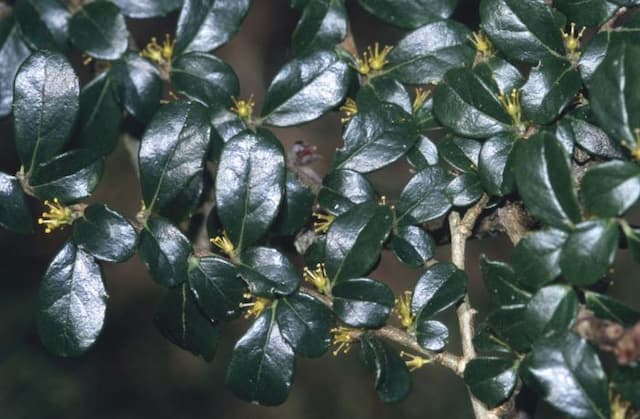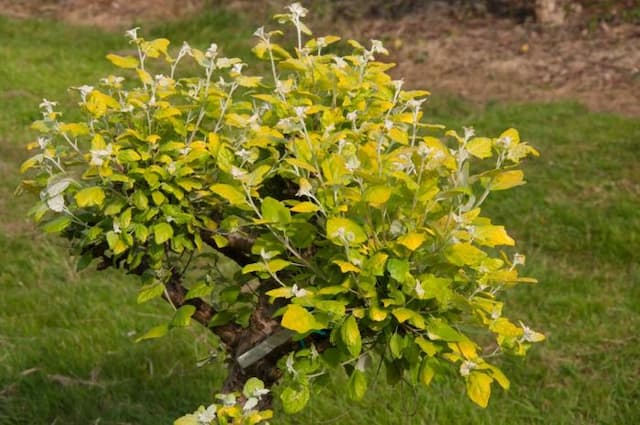Japanese Fantail Willow Salix udensis 'Sekka' (m)

ABOUT
The plant commonly known as Japanese Fantail Willow is a distinctive and ornamental plant with unique features. Its most striking aspect is perhaps the twisted and contorted branches that make it a popular choice for visual interest in gardens. The bark on these fascinating branches is smooth and has a shiny, reddish-brown color that adds to the plant's attractiveness year-round. The foliage of the Japanese Fantail Willow consists of elongated leaves, which typically emerge in a bright green hue in spring. As the season progresses, the leaves mature to a richer green, providing a lush backdrop for the contorted branches. The leaves may turn to a golden yellow in the fall, giving the plant an additional splash of color before the leaves drop. In springtime, the plant also sports catkins, which are long and slender flower clusters that can add a soft, textural element to its appearance. These catkins often appear before the leaves fully unfurl. Overall, the Japanese Fantail Willow is prized for its unique growth habit and the visual interest it lends to landscapes and gardens, even more so when its branches are bare in the winter months, showcasing their curious shapes.
About this plant
 Names
NamesFamily
Salicaceae
Synonyms
Japanese Fantail Willow, Dragon Willow, Sekka Willow
Common names
Salix sachalinensis 'Sekka'
 Toxicity
ToxicityTo humans
The Japanese fantail willow is not typically known for its toxicity to humans. Most parts of willow trees, including the Japanese variety, are not poisonous and do not generally pose a risk of toxicity when touched or ingested. However, willows contain salicin, a chemical similar to aspirin, which in large amounts can contribute to symptoms such as stomach upset, nausea, or diarrhea, particularly if an individual is sensitive to salicylate compounds.
To pets
The Japanese fantail willow is generally not considered toxic to pets. However, as with humans, the salicin found in willows can potentially cause gastrointestinal upset, such as vomiting or diarrhea, if consumed in large quantities. Owners should still prevent pets from ingesting large amounts of any plant material to avoid potential digestive issues.
 Characteristics
CharacteristicsLife cycle
Perennials
Foliage type
Deciduous
Color of leaves
Green
Height
10 feet [3 meters]
Spread
6 feet [1.8 meters]
Plant type
Shrub
Hardiness zones
5
Native area
Asia
Benefits
 General Benefits
General Benefits- Ornamental Value: 'Sekka' has a distinctive appearance with its contorted branches that add winter interest to gardens.
- Habitat for Wildlife: Provides shelter and sometimes food for birds and other wildlife.
- Erosion Control: Its root system helps stabilize soil, especially along stream banks and slopes.
- Windbreak: Can act as a natural wind shield when planted in groups or rows.
- Tolerates Wet Soil: This willow thrives in moist conditions where other plants may struggle.
- Fast Growing: Rapid growth rate makes it a good choice for areas in need of quick coverage or screening.
- Easy Propagation: Cuttings taken from 'Sekka' root easily, making it simple to propagate and share.
- Adaptable: Can grow in a variety of soil types, from clay to loam.
- Winter Interest: The contorted branches provide an attractive feature during the dormant season.
- Low Maintenance: Once established, requires minimal care beyond occasional pruning to shape or remove damaged wood.
 Medical Properties
Medical Properties- Anti-inflammatory: Salix species (willows) contain salicin, a compound that metabolizes into salicylic acid in the body, which can help reduce inflammation.
- Analgesic: The salicylic acid derived from salicin also has pain-relieving properties.
- Antipyretic: Willow bark has traditionally been used to help reduce fever.
- Antirheumatic: Its potential to alleviate pain and inflammation may be beneficial for rheumatic ailments.
 Air-purifying Qualities
Air-purifying QualitiesThis plant is not specifically known for air purifying qualities.
 Other Uses
Other Uses- Japanese Fantail Willow branches are often used in basket weaving due to their flexibility and strength.
- The wood can be utilized in the creation of small carved objects or rustic furniture, appreciated for its unique grain and texture.
- Gardeners may grow Japanese Fantail Willow as a natural privacy screen or windbreak due to its dense foliage and fast growth rate.
- In floral arrangements, branches of the Japanese Fantail Willow are used for their ornamental value, especially when they are contorted or uniquely shaped.
- The tree can serve as a host plant for butterfly larvae, promoting biodiversity within a garden setting.
- Dried branches are incorporated into artistic sculptures and installations, prized for their visual interest and natural beauty.
- Landscape designers use Japanese Fantail Willow for erosion control on banks or slopes because its root system helps to stabilize the soil.
- This plant can be a source of food for some bird species, particularly when other food sources are scarce in winter.
- When planted along rivers and streams, the Japanese Fantail Willow can help to filter and slow runoff, reducing potential water pollution.
- In bonsai culture, the Japanese Fantail Willow is shaped into miniature forms that mimic old, windswept trees, showcasing the artistry of the practice.
Interesting Facts
 Feng Shui
Feng ShuiThe Japanese Fantail Willow is not used in Feng Shui practice.
 Zodiac Sign Compitability
Zodiac Sign CompitabilityThe Japanese Fantail Willow is not used in astrology practice.
 Plant Symbolism
Plant Symbolism- Flexibility and Resilience: Commonly known as Japanese Fantail Willow, this plant's ability to bend without breaking symbolizes the human capacity to adapt and persist through challenges without losing strength.
- Growth and Renewal: The willow's robust growth and the greenness of its leaves represent the continual renewal of life, the idea of new beginnings, and the cycle of growth and regeneration.
- Healing: Traditionally, willows have been associated with healing, both due to the medicinal properties of their bark, which contains salicin (a precursor to aspirin), and symbolically offering comfort and recovery.
- Sorrow: Willows, in a broader sense, often symbolize sorrow or mourning, as their drooping branches suggest tears and melancholy, though this does not specifically tie to the 'Sekka' variety.
- Freedom: The free-form and seemingly unrestrained growth pattern of the Japanese Fantail Willow can be seen as a symbol of freedom, spontaneity, and the lack of confinement in nature or life.
 Water
WaterThe Japanese Fantail Willow, commonly known as Salix udensis 'Sekka', prefers steady moisture and should be watered deeply at least once a week. During hot or dry spells, watering frequency should increase to twice a week, ensuring the soil remains moist but not waterlogged. Each watering session should provide enough water to soak the ground around the roots; typically, for established trees, that means using approximately 5 gallons per watering. Newly planted saplings may require less water, about 2-3 gallons, depending on the size of the plant and the weather conditions. Consistency is key to maintaining the health and vigor of your Salix 'Sekka'.
 Light
LightThe Japanese Fantail Willow thrives in full sun to partial shade conditions. Ideally, situate the plant in a location where it can receive at least six hours of direct sunlight daily. While it can tolerate some shade, too much can lead to sparse foliage and reduced vigor. The best spot for this plant is an open area away from large trees or structures that could cast excessive shade.
 Temperature
TemperatureThe Japanese Fantail Willow can survive in a temperature range from -30°F to 120°F but prefers a temperate climate with colder winters and mild to warm summers. The ideal growing temperature is between 50°F and 75°F. Extreme heat can be stressful, so providing some afternoon shade in hotter regions is beneficial. Make sure the plant is well-watered during extreme temperature conditions for best health.
 Pruning
PruningThe Japanese Fantail Willow should be pruned to encourage its distinctive fan-tailed growth pattern and to maintain the plant's health by removing any dead, damaged, or diseased branches. Pruning is best performed in late winter or early spring just before new growth starts. It may be pruned annually or every other year as needed to shape the tree and remove any unwanted growth. Light thinning of the branches can help to improve air circulation and light penetration, which is beneficial for the plant's overall health.
 Cleaning
CleaningAs needed
 Soil
SoilThe Fantail Willow thrives in moist, well-draining soil, rich in organic matter. A blend of loamy garden soil, peat, and sand or perlite is ideal for potting. The soil pH should be between 6.0 and 7.5 to support healthy growth.
 Repotting
RepottingFantail Willow should be repotted every two to three years to refresh the soil and accommodate root growth. Younger, actively growing plants may require more frequent repotting.
 Humidity & Misting
Humidity & MistingFantail Willow prefers high humidity levels but can tolerate average room humidity. Aim for about 50-70% relative humidity for optimal growth.
 Suitable locations
Suitable locationsIndoor
Keep Fantail Willow in bright, indirect light indoors.
Outdoor
Plant Fantail Willow in partial to full sun outside.
Hardiness zone
4-8 USDA
 Life cycle
Life cycleSalix udensis 'Sekka', commonly known as the Sekka Japanese willow, begins its life cycle when the seeds are dispersed by wind or water, which then germinate in moist soil conditions. The seedlings establish themselves and enter a rapid growth phase, where they develop a strong root system and foliage. As the plant matures, it develops distinctive twisted branches and vibrant green leaves, followed by catkins, which are its flowering structures, typically appearing in early spring. After pollination by insects, the catkins produce seeds by summer that are ready for dispersal, completing the reproductive cycle. As a perennial, the Sekka Japanese willow will enter a period of dormancy during the winter months, shedding leaves and conserving energy. The cycle resumes the next spring as temperatures warm, with the plant continuing to grow and produce new shoots, gradually reaching its mature size and repeating the process annually.
 Propogation
PropogationPropogation time
Late Winter-Early Spring
The Salix udensis 'Sekka', commonly known as the Japanese Fantail Willow, is most frequently propagated by cuttings. This method is popular due to its simplicity and high success rate. Cuttings for this plant are best taken in late winter while the plant is dormant. A cutting should be about 6 to 10 inches (15 to 25 centimeters) long and include several buds. The bottom end of the cutting is dipped into rooting hormone to encourage root development and then planted in moist potting mix or directly into the ground. It's important to keep the soil consistently moist until roots have developed and new growth is evident, which indicates successful propagation. This method utilizes the willow's natural propensity for rooting easily, making it an accessible propagation technique for gardeners of all skill levels.









